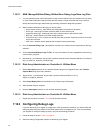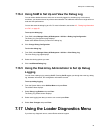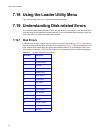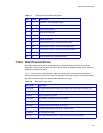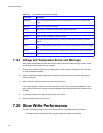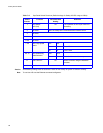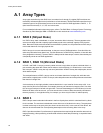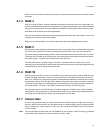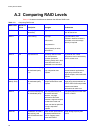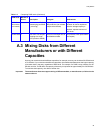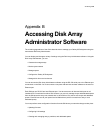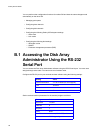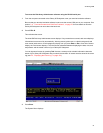Galaxy 65 User Guide
90
A.1 Array Types
Array types are defined by their RAID level, a number from 0 through 5 (a higher RAID level does not
necessarily indicate a higher level of performance or fault tolerance). Rorke Data RAID controllers let you
create the types of arrays that have proven to be the most useful for RAID applications: RAID 0, 1, 10
(also known as mirrored), 3, 4, 5, 50, and volume sets.
For more detailed information about array types, refer to The RAID Book: A Storage System Technology
Handbook by Paul Massiglia, ISBN 1-879936-90-9 or their web site at www.raid-advisory.com.
A.1.1 RAID 0 (Striped Disks)
In a RAID 0 array, data is distributed, or striped, across the disks in the array. The array appears to the
server as one large disk with a capacity approximately equal to the combined capacity of the physical
disks. Because multiple reads and writes can be handled in parallel, the I/O performance of the array is
much better than that of a single physical disk.
RAID 0 arrays do not store redundant data, so they are not true RAID applications. If one disk fails, the
entire array fails and all array data is lost. The fault tolerance of a RAID 0 array, therefore, is less than that
of any single disk in the array. The term RAID 0 is widely used for these arrays, however, because they are
conceptually similar to true RAID applications.
A.1.2 RAID 1, RAID 10 (Mirrored Disks)
In RAID 1 and RAID 10 arrays (commonly called mirrored arrays) disks are paired, with both disks in a
pair containing the same data. When data is written to a mirrored array, it is written twice—once to each
disk in the pair. A RAID 1 array has only one set of paired disks. A RAID 10 array has multiple pairs, across
which data is striped.
The read performance of RAID 1 arrays can be much better than that of a single disk, while the write
performance is slightly lower. In RAID 10 arrays, both read performance and write performance are better
than those of a single disk.
A mirrored array is also highly reliable, because both disks in a pair must fail for the array to fail. In an
array with five pairs of mirrored disks, for example, the array can maintain its integrity even if five disks
fail; as long as each pair is left with one good disk. The main disadvantage of a mirrored array is its cost.
Because all disks must have a twin, you must use twice the number of disks that actually contribute to
the array capacity. In an eight-disk array, for example, you have only four disks of usable capacity.
A.1.3 RAID 3
RAID 3 arrays contain redundant information in the form of parity data, which is calculated block-by-block
for all user data. The user data is distributed across all but one of the disks in the array. The parity data
is written exclusively to the parity disk (also known as the check disk). In the event of a disk failure, the
data can be reconstructed from corresponding data stripes on the remaining disks in the array.
RAID 3 provides excellent I/O performance for applications that require high data transfer rates such as
image processing, video processing, scientific data collection, batch data processing, or sequential reads
and writes.



